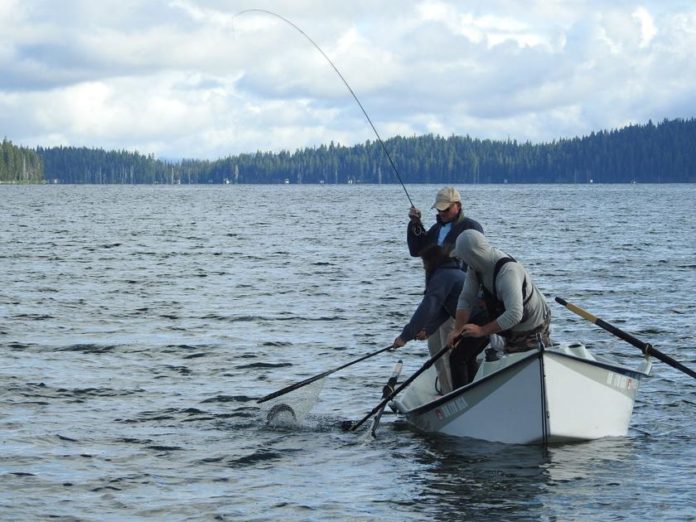Fishing license sales are up, way up over the last year. People are getting into fly-fishing at a rapid clip — across all age classes.
“One-hundred percent,” Chris Peichel said. “From young kids to people in their 60s and 70s. One of the things COVID has done is made people sick of playing video games and watching TV. They want something they can do outdoors. Fly-fishing is something that has intrigued them.”
Peichel has been fly-fishing since he was 14 (which was 35 years ago). Now, working at Fin & Fire in Redmond, he is seeing a lot of newcomers to the sport, picking up their first fly rods, buying their first trout flies, learning how to tie the knots and make the simple casts.
“We certainly saw a huge increase last year. As the weather gets warmer and warmer, we are going to see a lot more. They are coming in to get information on fly-fishing gear. They are people who have done very little fishing if any, people who have never really gotten into it.”
And now they’re getting into it.
A lot of people picture themselves taking their fly rods to the river, and here, that means the Crooked River, the Deschutes, Fall River and the Metolius. All of the fly shops in our area can point anglers in the right direction. But there is another way — still-water fishing.
A new angler should learn to cast, watch a few videos and get on the water. For the angler looking to catch a first trout on a fly, it is hard to beat our trout lakes. Let’s make this easy.
Buy, beg or borrow a boat — a float tube, car-topper or canoe. Tie on a 9-foot tapered leader to a floating or slow-sink line, cast out (or pull out) 40 to 60 feet of line and start trolling.
Best trout flies for still-water trout in the spring? Ask 100 people and get 50 different answers, but leech patterns head the list. The Mack’s Smile Blade Fly is a great trolling option from Diamond Lake to East Lake and Little Lava because of the mylar blade that throws flash and gives the fly great action. It comes in different color combinations, but I would put the top three as gold sparkle, copper scale and flame mirror.
Other good leech patterns for casting and trolling include blood red, black and olive tungsten or beadhead Mohair Buggers. Leeches should be weighted at the head so that they sink or wobble when the fly isn’t moving. Other favorites include the Rufus patterns and Foisset’s TWS.
With the rod strung, a fly on the leader, and a rising barometer, where are the fish biting? In April, a couple of the best Central Oregon destinations are Pine Hollow Reservoir and Rock Creek Reservoir, near Wamic and Tygh Valley. Both lakes will be planted with good numbers of legals and larger brood stock, which can weigh 6 to 8 pounds. Detroit Reservoir will also get regular plants of hatchery fish starting in April.
By mid-to-late April, as the waters warm, Laurance Lake (near Mt. Hood) and both South Twin and North Twin will be good bets.
In May, Ochoco Reservoir, Antelope Flat and Walton Lake will come into play. The shallows warm first, which promotes weed growth and bug life. Trout will be in the shallows, along weed beds and near the drop-offs. Up on Mount Hood, Clear Lake is a good fair-weather choice, whenever the wind isn’t blowing too hard.
With warmer days and early trout stocking, there are a lot of fish to catch and one of them could be your very first trout on a fly.
—Gary Lewis is the host of “Frontier Unlimited TV” and author of “Fishing Central Oregon,” “Fishing Mount Hood Country,” “Hunting Oregon” and other titles. Contact Gary at www.GaryLewisOutdoors.com.
—Gary Lewis, for The Bulletin
Credit: Source link































